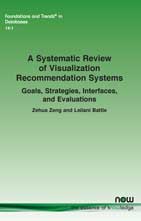A Systematic Review of Visualization Recommendation Systems: Goals, Strategies, Interfaces, and Evaluations
By Zehua Zeng, University of Maryland, College Park, USA, zhzeng@terpmail.umd.edu | Leilani Battle, University of Washington, USA, leibatt@uw.edu
Abstract
Visualization recommendation systems help data analysts navigate large, complex datasets by generating visualizations of meaningful patterns, outliers, and insights that could influence downstream decision-making. However, recommendations can easily mislead or confuse analysts when they are not developed with care. In this survey, we review how visualization recommendation systems have been designed over the last 25 years and classify them by their underlying recommendation goals and high-level implementation strategies, including the user interfaces provided for navigating and interpreting the recommended visualizations. To understand their efficacy, we also review how visualization recommendation systems are evaluated in the literature. Given these observations, we present several open challenges and promising directions for future work in designing effective visualization recommendation systems.
A Systematic Review of Visualization Recommendation Systems: Goals, Strategies, Interfaces, and Evaluations
Visualization recommendation systems help data analysts navigate large, complex datasets by generating visualizations of meaningful patterns, outliers, and insights that could influence downstream decision-making. However, recommendations can easily mislead or confuse analysts when they are not developed with care.
This monograph reviews how visualization recommendation systems have been designed over the last 25 years, and classifies them by their underlying recommendation goals and high-level implementation strategies, including the user interfaces provided for navigating and interpreting the recommended visualizations. To understand their efficacy, this work also reviews how visualization recommendation systems are evaluated in the literature. Given these observations, several open challenges and promising directions for future work in designing effective visualization recommendation systems are presented.
